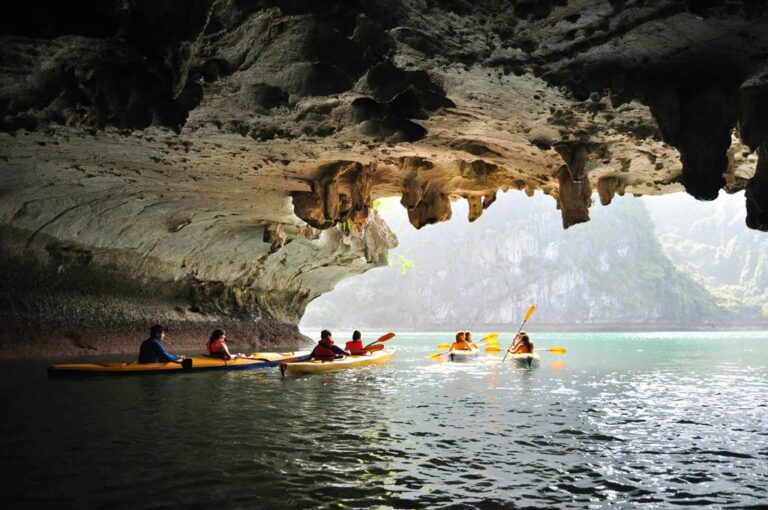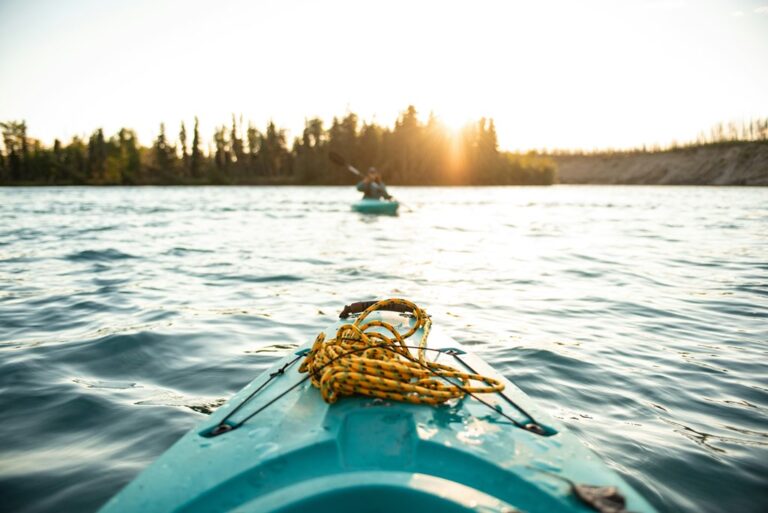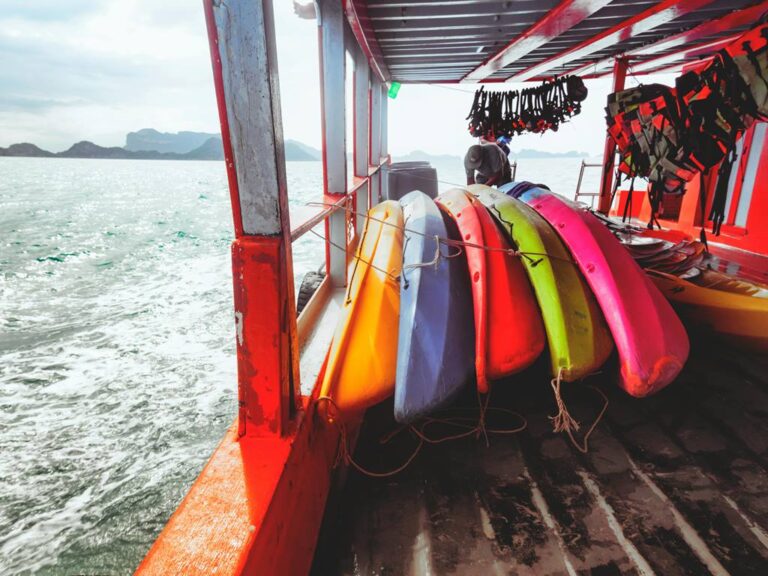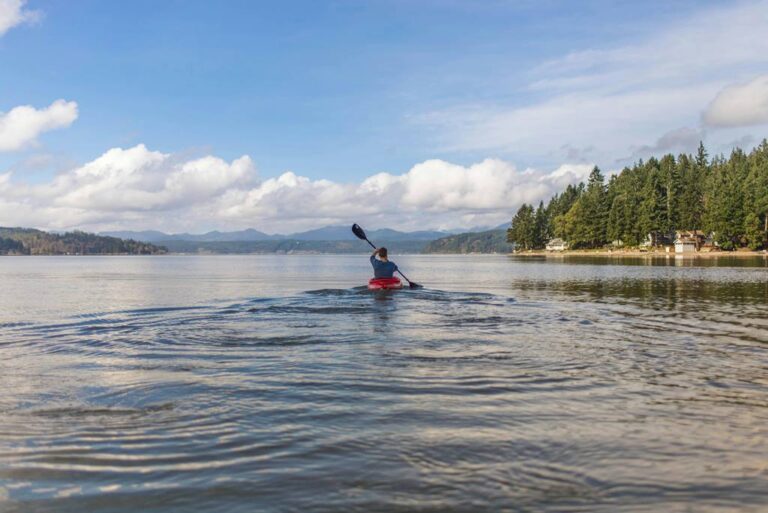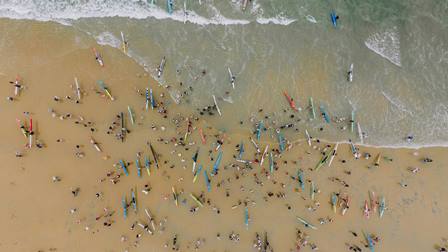
Kayaking unlocks a world of adventure. Imagine paddling to secluded beaches, exploring hidden coves, or simply enjoying a peaceful sunrise on the water. The possibilities are endless! But with a vast array of kayaks available, selecting the right kayak can feel overwhelming. To navigate this exciting process, focus on a few key factors when Selecting the Right Kayak.
Table of Contents
Selecting the Right Kayak: Your Guide to Calm Waters
1. Charting Your Course: Where Will You Paddle?
The type of water you plan to explore significantly impacts your kayak selection. Here’s a breakdown:
- Calm Lakes and Rivers: Look for stable and manoeuvrable kayaks, often shorter and wider for easy turning. Recreational sit-in or sit-on-top kayaks are great options.
- Open Seas and Coastlines: For longer distances and choppier waters, prioritize stability and tracking. Touring kayaks, typically longer and narrower, are ideal for these adventures.
2. Sit-in or Sit-on-Top? Choosing Your Comfort Zone
This boils down to personal preference. Sit-in kayaks offer a more secure and weather-protected experience, while sit-on-top kayaks provide easier entry and exit, perfect for swimming or fishing.
3. Weight and Budget: Striking a Balance
The materials used in kayak construction heavily influence weight, durability, and price. Polyethylene kayaks are affordable and robust, but heavier. Lighter composite kayaks are easier to transport but come with a higher price tag. Consider how often you’ll transport your kayak and how much you’re comfortable spending.
4. Size and Shape: Finding the Perfect Fit
The size and shape of your kayak affect its handling and storage capacity. Longer kayaks track straighter and are faster, while shorter ones are more manoeuvrable. Wider kayaks offer better stability, while narrower ones prioritize speed. Consider your height, weight, and the gear you’ll typically carry when evaluating size.
Where Do You Plan to Kayak?
While kayaks aren’t strictly categorized by water type, it’s a great starting point to consider your paddling environment. Here’s a breakdown to help you choose the right kayak for your next adventure:
Calm Waters: Lakes and Serene Rivers
- Protected Play: For leisurely outings on calm lakes or gentle rivers, a recreational sit-in or sit-on-top kayak offers stability and ease of use. Stick to shorter distances and fair weather if using a purely recreational model.
- When Conditions Change: If you encounter choppy water or plan for longer distances, consider a day-touring kayak. These sit-in kayaks provide better tracking and handle waves more confidently.
Open Waters: Embracing the Coast
- Taming the Elements: When wind, waves, currents, and tides are factors, prioritize a sit-in touring kayak. Look for features like rudders, fixed tracking fins, or skegs (retractable fins) for better control.
- Warm Waters, Open Mind: Sit-on-top kayaks remain an option in warm climates, especially for activities like swimming or kayak surfing. Just be aware of potential limitations in rougher conditions.
Moving Waters: Exploring Rivers (Calm Stretches)
- Manoeuvrability Matters: For calm rivers, stability and quick turning are key. Short recreational kayaks (sit-in or sit-on-top) or day-touring kayaks excel here.
- Versatility for Both: If you plan to paddle on both lakes and rivers, opt for a short recreational kayak with a skeg. This “crossover” design allows for responsive turning with the skeg up and efficient tracking with it down. A short boat with a rudder could also be an option, although rudders are more common on longer kayaks.
Different Types of Kayaks
The world of kayaks offers a variety of choices, categorized by seating position, intended use, construction, and purpose. Let’s delve into the two main types: sit-on-top and traditional sit-in kayaks, to help you find your perfect paddling match.
Sit-on-top Vs. Traditional Sit-in Kayaks
Sit-on-Top Kayaks: The Easygoing Choice
Think laid-back lake adventures or gentle river floats. Sit-on-top kayaks are ideal for recreational paddling in calm waters. They’re also popular in warm coastal areas, and some longer models even offer overnight storage.
Why Choose Sit-on-Top?
- Effortless Entry and Exit: Getting in and out of a sit-on-top is a breeze, even in deep water. This makes them perfect for casual use, like exploring near a lake cabin, or as a platform for swimming and lounging.
- Warm Weather Comfort: When the sun is shining and the water is warm, sit-on-tops offer a comfortable paddling experience. However, be prepared to get wet!
- Self-Draining Design: Scupper holes allow water to drain naturally, eliminating the need for a bilge pump.
- Storage Solutions: While internal cargo space might be limited, sit-on-tops often feature deck compartments for easy-access gear.
Things to Consider:
- Weight: Compared to similar sit-in kayaks, sit-on-tops tend to be heavier.
- Fishing Friendliness: Many sit-on-tops come equipped with rod holders, or offer the option to add them, making them perfect for fishing enthusiasts.
Sit-In Kayaks: Geared for Performance and Exploration
Sit-in kayaks come in various models, from recreational for leisurely paddling to day touring and touring for longer expeditions. They prioritize speed, tracking (straight-line movement), and offer covered compartments for gear – ideal for reaching specific destinations.
Why Choose Sit-In?
- Cool Weather Comfort: Sit-in kayaks offer better protection from the elements, making them more comfortable in cooler temperatures.
- Enhanced Control: Your body position and multiple contact points (seat, knees, feet) inside the cockpit provide greater control, especially valuable in rough waters and for manoeuvring.
- Paddling Efficiency: Sit-in kayaks require less effort to paddle compared to sit-on-tops.
Things to Consider:
- Learning Curve: Mastering a wet exit (escaping a capsized kayak) is essential for traditional sit-in kayaks.
- Staying Dry (Mostly): You can add a spray skirt to minimize water entry, but a bilge pump is still recommended for complete water removal.
Beyond the Basics: Exploring Specialty Kayaks
While sit-in and sit-on-top kayaks cover a wide range of uses, there are also specialized options to consider:
- Folding Kayaks: Ideal for storage limitations or remote trips, offering portability and handling similar to touring kayaks.
- Inflatable Kayaks: Great for storage and surprisingly versatile. Recreational models prioritize stability for calm water play, while rugged inflatables excel in flowing rivers. High-performance inflatables cater to serious touring.
- Tandem Kayaks: Perfect for paddling with a partner or kids. Offers stability and potential cost savings compared to buying two solo kayaks, but limits solo paddling and rescue options.
- Pedal-powered Kayaks: Free your hands for fishing or photography with these innovative kayaks. Pedal propulsion offers comfort and endurance, but adds cost, maintenance, and limits manoeuvrability in tight spaces or rough water. They’re also heavier and require trailer transport.
Categories of Kayaks
The world of kayaks offers a variety of options, categorized by intended use, features, and sometimes even seating position. However, it’s important to note that kayak manufacturers aren’t always consistent with their terminology. One brand’s “recreational” kayak might be similar to another brand’s “day touring” model.
Recreational kayaks: Sit-in and Sit-on-top Models
Recreational kayaks are the perfect entry point for paddlers seeking a relaxed and enjoyable experience on calm water. Here’s what makes them ideal for flatwater adventures:
- Budget-Friendly: They’re typically the most affordable option among kayaks.
- Stable Platform: Their wider design provides excellent stability, perfect for beginners or those who prioritize comfort.
- Effortless Entry/Exit: Getting in and out is a breeze, thanks to their open cockpits.
- Maneuverable: They’re easy to turn and navigate, ideal for exploring calm coves and leisurely paddling.
Things to Keep in Mind:
- Limited Storage: Recreational kayaks typically offer minimal storage space, suitable for stashing essentials like sunscreen and snacks.
- Calm Water Focus: They’re not designed for rough waters, waves, or long distances. Stick to lakes, gentle rivers, and protected coastal areas.
Kayaks for Day Trips (sit-ins)
Day touring kayaks are the perfect stepping stone for paddlers seeking to venture beyond calm waters. Here’s what makes them ideal for extended adventures:
- Enhanced Performance: Sleeker and more efficient than recreational kayaks, they offer improved tracking (moving in a straight line) and better handling in choppier water, giving you more confidence as you explore.
- Moderate Cargo Capacity: Compared to recreational models, day touring kayaks offer more storage space for day trips, allowing you to pack essentials and gear for a comfortable journey.
- Manageable Size: While offering more performance than recreational kayaks, they remain shorter than sea kayaks, making them easier to transport and maneuver on land.
Investing in Performance: Day touring kayaks typically come with a higher price tag compared to recreational models. This reflects the improved materials and design for better paddling efficiency and handling.
Kayaks for Touring (sit-in sea kayaks)
Touring kayaks, also known as sea kayaks, are built for distance and adventure. These robust vessels are ideal for paddlers who crave the challenge and beauty of longer expeditions and coastal exploration.
Built for Efficiency:
- Superior Tracking: Their long, sleek design ensures exceptional tracking, allowing you to cover vast distances with minimal effort.
- Weathering the Elements: Rudder or skeg systems provide excellent control in windy conditions and strong currents, keeping you on course even in challenging environments.
Geared for Long Hauls:
- Ample Storage: Touring kayaks offer the most cargo space of all kayak categories, allowing you to pack everything you need for multi-day trips and camping adventures.
Investing in Exploration:
- Premium Price: The advanced design and materials used in touring kayaks are reflected in their higher price tag.
Choosing Your Course:
- Long-Term Commitment: If you know your heart belongs to extended coastal kayaking, a touring kayak is a wise investment from the start.
- Developing Skills: For those who are new to paddling or unsure about long-distance adventures, a day touring kayak offers a more affordable option to hone your skills before tackling longer journeys.
Kayaks Designed for Specific Purposes
Beyond the core categories of recreational, day touring, and touring kayaks, there’s a world of specialized kayaks designed to cater to unique paddling needs:
- For Space-Conscious Paddlers: Folding Kayaks
Living in an apartment or tight on storage? Folding kayaks are your lifesaver! They collapse into compact units for easy storage and transportation, while still offering impressive handling and performance comparable to touring kayaks.
- Inflatable All-Stars: Inflatable Kayaks
Don’t be fooled by their inflatable nature – these versatile kayaks are surprisingly durable and offer a great balance of portability and functionality. Recreational models prioritize stability for calm water play, while rugged inflatables excel in flowing rivers. For serious touring enthusiasts, high-performance inflatable kayaks are also available.
- Sharing the Adventure: Tandem Kayaks
Planning to paddle with a partner or bring the kids along? Tandem kayaks provide a spacious and stable platform for shared paddling adventures. They can also be a more cost-effective option compared to buying two solo kayaks. However, keep in mind that tandem kayaks limit solo paddling and rescue options.
- Fishing Focus: Pedal-Powered Kayaks
For fishing enthusiasts, pedal-powered kayaks are a game-changer. These innovative kayaks free your hands for casting lines, reeling in catches, or using photography equipment. Pedal propulsion offers increased comfort and allows you to conserve energy while exploring fishing grounds. While offering several advantages, pedal-powered kayaks come with a higher price tag due to their complex mechanisms. They also require more maintenance and can be less maneuverable in tight spaces or rough waters. Additionally, their weight often necessitates trailer transport.
Kayak Construction, Material, Weight, and Cost
The weight of your kayak plays a significant role in how you experience your paddling adventures. Here’s a breakdown of the most common materials and their impact on weight, price, and performance:
Lightweight Champions: Enhanced Performance (but Higher Price Tag)
- Fiberglass and Carbon Fiber: These composite materials offer the ultimate in lightweight construction. They translate to easier carrying, faster paddling speeds, and the ability to carry more gear. Fiberglass offers a good balance, while ultralight carbon fiber prioritizes weight savings at a premium price. However, both materials are susceptible to damage from sharp impacts.
Durable Choices: Balancing Weight and Affordability
- Polyethylene Plastic: The most affordable option, polyethylene kayaks are incredibly durable and resist scratches and abrasions well. However, they are the heaviest of the bunch and susceptible to UV degradation over time. Proper storage (out of direct sunlight) is crucial.
- ABS Plastic: Slightly more expensive than polyethylene, ABS offers similar durability with a slight weight reduction and some UV resistance. This translates to a more manageable weight and better sun protection for your kayak. Thermoformed ABS kayaks are recognizable by their distinct two-tone hulls, a result of separately molded deck and hull sections bonded together.
Remember: There’s always a trade-off. While a lighter kayak offers advantages in handling and speed, it often comes at a higher cost. Consider your paddling style, budget, and storage capabilities when choosing the material that best suits your needs.
Other Factors to Consider When Choosing a Kayak
Picking the perfect kayak goes beyond just its category. Here’s a breakdown of key specifications to consider for an optimal paddling experience:
Weight Capacity: This crucial spec encompasses the total weight of yourself, your gear, and the kayak itself. Exceeding the weight capacity can cause your kayak to sit too low in the water, hindering paddling efficiency and stability. Consider the type of trips you plan (overnight vs. day trips) and pack weight accordingly.
Length: Generally, longer kayaks track straighter and offer more storage space for extended adventures. Shorter kayaks, on the other hand, boast superior maneuverability. While a few inches in length might not make a huge difference, a difference of two feet or more will be noticeable.
Depth: Deeper hulls provide more legroom and additional storage for taller paddlers. Shallower hulls, however, are less susceptible to windblown effects.
Width: Wider kayaks offer greater initial stability, ideal for beginners or those who prioritize comfort. Narrower kayaks, while less stable initially, can achieve faster speeds.
Tracking Control: Skegs, tracking fins, and rudders all contribute to a kayak’s directional stability, especially in windy conditions:
- Skeg: A simple, retractable fin that counteracts side winds and keeps you on course.
- Tracking Fin: Similar to a skeg, but fixed in place, offering less maneuverability but improved tracking. Some inflatable kayaks come equipped with tracking fins, which can be removed if quick turns are a priority.
- Rudder: A movable fin controlled by foot pedals, allowing for constant adjustments to maintain course even in changing wind and current conditions.
Seat Comfort: Investing in a comfortable seat can significantly enhance your paddling experience. Adjustable, padded, and ergonomic seats can make a world of difference, especially on longer outings.
Cockpit Size: Smaller cockpits provide more control and protection in rough waters, while larger cockpits offer easier entry and exit. Consider your paddling environment and priorities when making this choice.
Hatches: These compartments provide access to storage space within the kayak. Touring kayaks typically have two hatches for maximum storage, while day touring kayaks and some recreational models may have one.
Conclusion
Selecting right kayak hinges on your paddling style, planned activities, and personal comfort. Consider these key factors:
- Paddling Environment: Calm lakes or adventurous coasts?
- Seating Preference: Sit-in for control or sit-on-top for ease of entry/exit?
- Weight & Budget: Factor in weight capacity and desired features.
- Size & Shape: Explore length, width, and storage options.
With these considerations, you’re well on your way to finding your perfect kayak match and unlocking a world of aquatic adventures!


